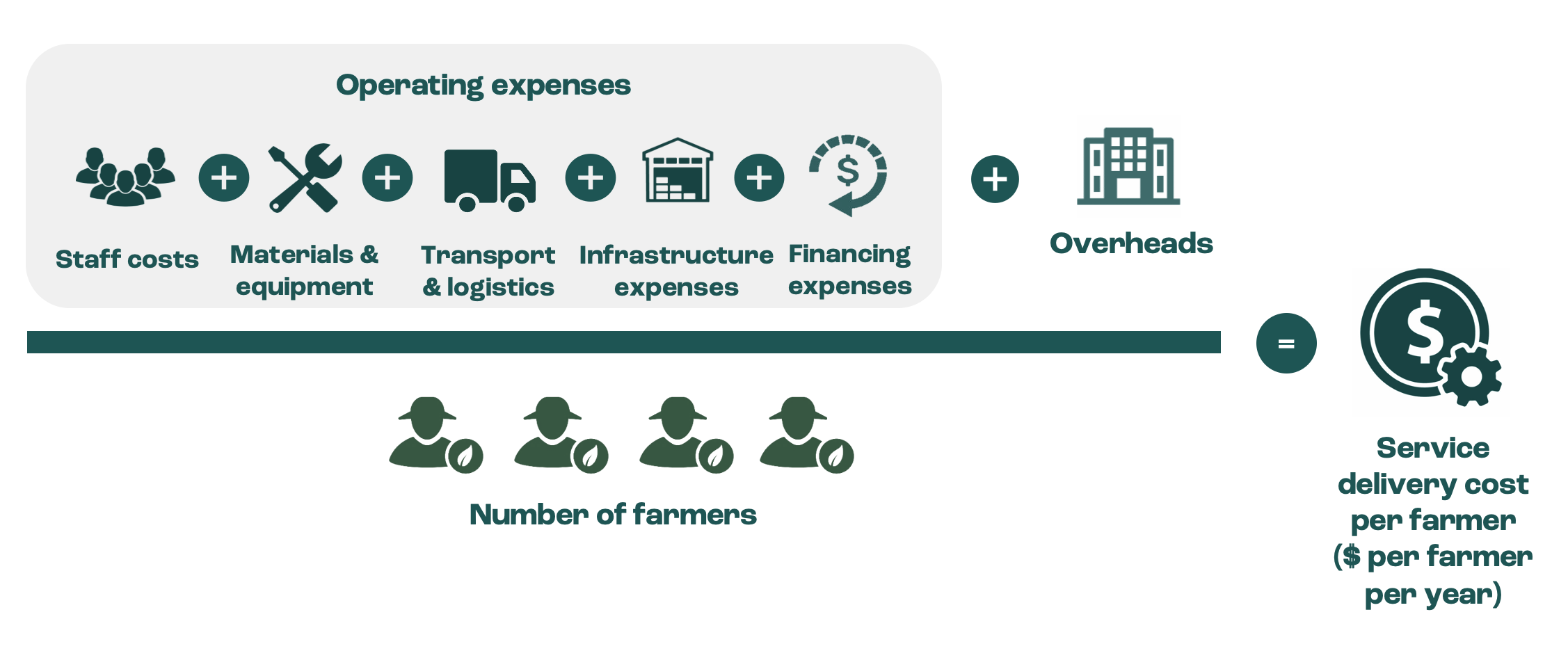Service Delivery Cost per Farmer
What we mean by service delivery cost per farmer
The amount a company invests in service delivery to smallholder farmers is crucial to understanding their business model and identifying potential risks and opportunities. Knowing this helps companies identify opportunities to more efficiently offer goods and services to farmers or to increase their investment levels, while optimizing for other outcomes such as
Service delivery cost per farmer refers to the average, annual cost of service delivery to farmers as visualized below.

The FarmFit data, covering over 100 business models, shows a huge spread in the service delivery cost per farmer per year. Figures range from a minimum of $2.5 to a maximum of $4,382, with mean and median values of $276 and $77, respectively.
Why is it so important to understand service delivery cost?
Among the many benefits of studying this indicator, there are two we want to highlight:
Firstly, as highlighted in the New Paradigm section, there is a massive need for increasing private sector investment in smallholder farmers. Understanding how much companies are investing today on a per-farmer basis allows us to identify patterns across different contexts and types of models. Better data allows us to identify how smallholder-inclusive business models can reach optimal levels of investment and efficiency in different contexts.
Secondly, due to a lack of credible and comparable data, there is currently very little visibility and comparability on the efficiency of service delivery. We see that there is often a large difference in average per-farmer investment between similar models and in comparable contexts. This suggests that there is potential for offering the same services with the same outcomes, but at a reduced cost. This would allow the same finite resources to be spent on more farmers and create more impact.
There exists a range of more specific benefits to studying and understanding service delivery cost that differ for different types of organizations, including:
- Benchmarking costs of service provision against peers
- Set accurate and relevant internal targets
- Understand how to optimize for investment per farmer through business model design options or adapting to context
- Identify ways of overcoming cost-related barriers to scaling
- Determine companies’ investability by comparing their financial performance. How does service delivery cost per farmer compare against peers for companies in your portfolio or pipeline?
- Provide input for periodic performance measurement and benchmarking of investees
- Inform geographic or sectoral strategies by better understanding context-specific determinants and drivers of the cost to serve
- Identify and assess what business model to support based on potential pockets of inefficiency and / or under-investment
- Provide input to a toolkit of support interventions that can help supported companies optimize cost
- Provide insights into how (finite) development and philanthropic capital can be allocated to contexts (e.g., geographic, farmer segments, types of services) where investment per farmer is lower than others
- Help identify grant, philanthropic and/or public investments to put in place measures that can help reduce service delivery cost per farmer in a specific context (country, region, crop). Examples would be around infrastructure that would reduce last mile delivery costs (e.g., promoting agent models, organizing farmers) in close collaboration with the private sector
Our insights on service delivery cost per farmer
There is a large spread in service delivery cost per farmer per year for the 100+ models that we have analyzed, ranging from less than $5 per year to over $5,000. Till date, the Insights Hub has found the most interesting relationship between service delivery cost per farmer and the following other
Other outcomes
Contextual Drivers
Design drivers
Your Insights Hub journey has just started
Sign up here for access to updates - and industry insights and innovation - from the Smallholder Inclusive Business Newsletter.